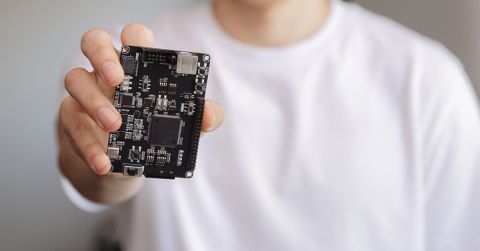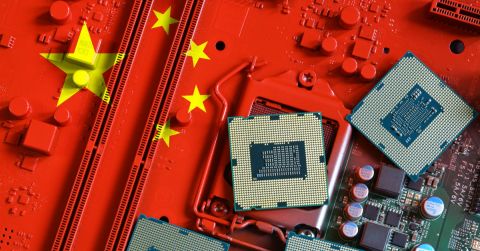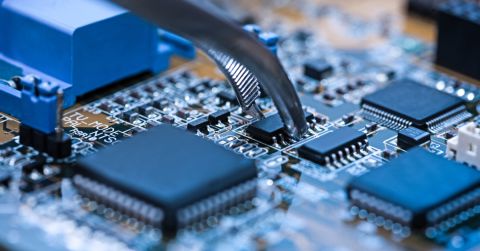Components for Software-Defined Radio Hardware

Would you like to listen to ISS radio transmissions and collect their data? Build a software-defined radio hardware system.
If you want to listen to satellite broadcasts, connect to your smart home systems, check your GPS location, surf the internet, and pick up FM radio signals all at once, you don’t need a radio with multiple transceivers. Software-defined radio is one design methodology that shifts the RF design burden from the hardware designer to the software developer, giving a new RF system more flexibility.
Software-defined radio isn’t for everyone, and it isn’t marketed as such. This concept and the hardware to support it has been embraced by the open-source community. Software-defined radio primarily finds its home in the military, who make copious use of adaptive frequency-hopping radio solutions. With many newer IoT devices potentially needing multiple wireless protocols, software-defined radio provides a simple way to communicate over multiple RF bands without increasing the footprint of your device or complicating your layout.
The Value of Software-Defined Radio
Just to illustrate the value that could be provided by software-defined radio, I’ll briefly discuss a recent project for a client. A recent board we designed for a test and measurement system included five (yes, five) wireless transceiver units, all operating over different protocols with different modules. Although software-defined radio was proposed as a solution, the client was stuck to their requirements for a number of reasons.
The value of software-defined radio in this unique case applies in many other cases; it allows the designer to consolidate multiple protocols into a single transceiver unit. In the board I referenced above, the majority of board space was taken up by electromechanical components and a large touch screen, so it made less sense to push for software-defined radio. However, there are some common use cases that justify building software-defined radio into a new product:
Multiple protocols. This one is obvious but still deserves some elaboration. Software-defined radio gives you access to multiple bands in a single component without increasing part count.
Board space savings. You can eliminate one or more transceivers dedicated to other protocols by using software-defined radio. This saves board space for components that can support other functions.
Primary vs. secondary protocols. With software-defined radio, you can access extra protocols on an as-needed basis without dedicating space to an additional chipset.
Eavesdropping. Whether you want to eavesdrop on unencrypted communications, or you want to prevent eavesdropping, software-defined radio makes both possible. In particular, frequency hopping radio is easy to implement using software-defined radio.
MCU SoCs with integrated wireless transceivers have gone in this direction as of late. Some product lines have integrated a popular protocol like WiFi or Bluetooth, but I haven’t seen transceivers for other less-often used protocols integrated into these chips. This is partially a supply and demand problem; these components mostly target consumer products, so they can be produced at huge scale. In addition, much of the wireless landscape runs on these two protocols (in addition to cellular) that it makes sense to target them for integration into an SoC. We can’t leave cellular out of the mix; some components are specifically marketed as supporting 3G and 4G cellular in addition to other frequency bands (see below).
This leads to the primary tradeoff involved in designing for software-defined radio with production-grade components: higher costs. These components are still produced in lower volume than their SoC counterparts and other RF transceivers dedicated to specific bands, so these components come with higher prices to cover costs. However, the savings in board space and flexibility might hugely outweigh the component costs.
Software-Defined Radio Component Options
The primary component you’ll need to select for a software-defined radio system is a transceiver IC. These components are built with standard interfaces and some other features, making them ideal for integration into other wireless products. You’ll need an embedded processor of some sort to run your code, but your choice of MCU/FPGA/other processor depends on the transceiver setup you’ll use.
Here are some options for your next software-defined radio system.
Analog Devices, AD9361
The AD9361 from Analog Devices is a highly integrated broadband transceiver solution that supports software-defined radio hardware. This product is marketed for military use, as well as for 3G and 4G base stations, but it supports other bands from 70 MHz to 6 GHz with FDD or TDD operation. The integrated fractional PLL provides extremely accurate step size down to 2.5 Hz, as well as tunable channel bandwidth from 
Evaluation board layout showing a block diagram for an AD9361 programmable 2 × 2 integrated transceiver. [Source: Analog Devices Product Brief]
Other components in the RadioVerse series from Analog Devices include the other transceivers in the AD936X family and the AD9375. The latter is intended to provide smartphone makers and telecom companies an easy way to transition from 4G to 5G NR without requiring handset changes. Analog Devices has produced the one software-defined radio transceiver with the most integration to date. Aside from this component and its variants, the other way to get started developing for software-defined radio is to choose a broadband synthesizer and receiver.
Maxim Integrated, MAX2150
The MAX2150 from Maxim Integrated is a trimmed-down broadband synthesizer for use in software-defined radio and other RF applications. This particular component targets applications running from 700 MHz to 2300 MHz, providing a broad spectral range. As a precision synthesizer built on a fractional PLL, it provides below 0.05 Hz resolution when used with a 10 MHz reference clock. This component also includes an output driver amplifier, which eliminates the use of an external RF amplifier except when very long range is required.

Supply current, output power, and block diagram for the MAX2150, from the MAX2150 datasheet.
Other Components for Software-Defined Radio
Aside from these two components, the only options for integrated transceiver ICs on the market are an off-brand component that I wouldn’t recommend. Still, you can build out your own transceiver module with a small footprint using a host of other components. These include:
General-purpose DSP components (if you opt to not perform DSP on an MCU)
RF filters
Synthesizers, transmitters, and receivers
Whether you want to capture multiple transmissions at once or you need to consolidate components into a smaller package, you can find the software-defined radio hardware components you need with the right electronics search engine. Octopart gives you a complete set of search tools with advanced filtration features for sourcing and supply chain management. Take a look at our integrated circuits page to get started on your search for the components you need.
Stay up-to-date with our latest articles by signing up for our newsletter.









 Back
Back